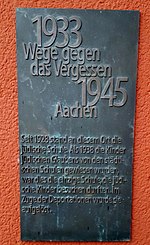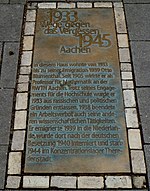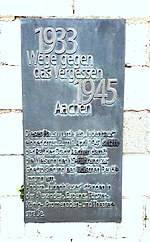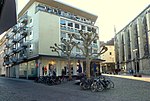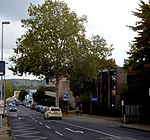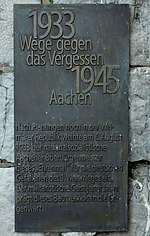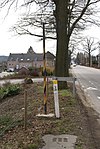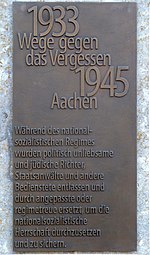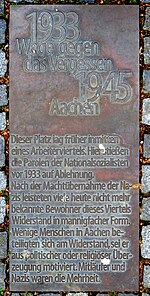Ways against forgetting
The Paths Against Forgetting 1933–1945 is a project to commemorate the atrocities of the National Socialists in Aachen . This project was initiated in 1994 by individual citizens, parties and other groups and approved in October 1996 with the votes of the CDU , SPD and Greens in the city council. The conception was transferred to the Volkshochschule Aachen in 1997 and the implementation has been financially supported by the city of Aachen since 2004. Since 2008, the project has been recognized nationwide as a competence center for political remembrance work in the region, both in matters of commemoration and dealing with the time of National Socialism in Aachen and with current right-wing extremism and is therefore a co-opted member of the " Working Group of Nazi Memorials and - Places of Remembrance in North Rhine-Westphalia ”.
The basic idea of the initiative was that, due to the decreasing number of contemporary witnesses of the Nazi era, there was a need for an educational offer for school classes in particular and for the population in general as well as for interested tourists. It is intended to remember the people who were persecuted by the Nazi dictatorship or who were murdered for political, racist, ideological, religious and other reasons. Research by the Volkshochschule Aachen has meanwhile found more than 40 authentic memorial sites that could be used for mounting a memorial plaque under the guidelines listed above. Further research is ongoing and new places for memorial plaques are explored.
The graphic designer Klaus Endrikat from the Aachen University of Applied Sciences was able to be won over as the artist for the creation of the memorial plaques . Up to now, the tall, rectangular bronze panels have mostly been attached to house walls and are seldom laid as floor slabs or erected as steles. City tours, workshops and much more are offered by the adult education center or the tourist office of the city of Aachen, including detailed information about the places worth remembering on the VHS website.
Stations
Sorting according to the serial number of the VHS list
card with all coordinates: OSM | WikiMap![]()
| address | Blackboard inscription | image |
|---|---|---|
| Jewish School, Bergdriesch 39 ( location ) (school building no longer exists) |
The Jewish school had stood here since 1928. When in 1938 the children of Jewish faith were expelled from the city schools, this was the only school that Jewish children were allowed to attend. It was dissolved in the course of the deportations. | |
|
Main building of RWTH Aachen , Templergraben 55 ( location ) |
In the years 1933 to 1935 the German universities were “Aryanized” and politically “brought into line”. As part of these measures, the professors and lecturers at RWTH Aachen
dismissed from their offices. An unknown number of students and assistants have also been evicted from the college for racial and political reasons. |
Memorial plaque temporarily dismantled for renovation work |
| Limburger Straße 22 ( location ) |
Otto Blumenthal lived in this house from 1933 until his emigration in 1939 . From 1905 he worked as a professor of mathematics at RWTH Aachen. Despite his commitment to the college, he was dismissed in 1933 for racial and political reasons. In 1938, a work ban ended his other scientific activities. He emigrated to the Netherlands in 1939, was interned there after the German occupation in 1940 and died in 1944 in the Theresienstadt concentration camp. | |
| Benno-Levy-Weg, Aachen- Haaren ( location ) |
Between the Hergelsmühle (demolished in 1975) and this row of poplars, there was a wooden barrack for the homeless in 1928. From July 1941 to July 1942, this barrack served as a collection camp for Jewish residents of the communities of Brand , Broichweiden , Haaren, Kohlscheid and Würselen . They were deported to the Lublin-Izbica and Theresienstadt concentration camps. | |
|
Aachen Central Station ( location ) |
For many people, Aachen Central Station was the last German station on their escape from Nazi persecution from 1933 onwards. They fled to Belgium, France, Great Britain, the Netherlands, the USA, Palestine ... For many people, the train stations were also the first stop on their way of being abducted and deported. From 1942, most of the Jewish Aacheners still living in the city were deported to the extermination:
March 25, 1942 to the East |
|
|
Judenhaus , Försterstraße 28 ( location ) |
This house was set up as a “Jewish house” for married couples in a so-called “mixed marriage”. On April 1, 1941, the City Council of Aachen implemented the instructions of the Nazi leadership to ghettoise the Jewish population. Other “Jewish houses” were in Alexander-, Eupener-, König-, Promenaden-, Theater- and Trierer Straße. | Memorial plaque currently not attached |
| Judenhaus, Königstraße 22 ( location ) |
This house was set up as a "Judenhaus". On April 1, 1941, the City Council of Aachen implemented the instructions of the Nazi leadership to ghettoise the Jewish population. Other “Jewish houses” were in Alexander-, Eupener-, Förster-, Promenaden-, Theater- and Trier Straße. |
|
| Judenhaus, Former Niessen Cloth Factory, Drosselweg ( location ) |
This house was set up as a "Judenhaus". On April 1, 1941, the City Council of Aachen implemented the instructions of the Nazi leadership to ghettoise the Jewish population. Other “Jewish houses” were in Alexander-, Eupener-, Förster-, König-, Promenaden- and Theaterstraße. | |
|
Jewish cemetery , Am Haarberg, Aachen-Haaren ( location ) |
In 1839 the Haaren community laid out its Jewish cemetery. In November 1938, a few days after the Reichspogromnacht , citizens of Haaren knocked over all the gravestones. In autumn 1939 the stones from the entire cemetery were transported to the village. Until 1997 they served as an embankment wall on Alt-Haarener-Straße. | |
| Ronheider Weg - Gut Entenpfuhl (cannot be precisely localized) |
Aachen was an important escape station for many persecuted:
"Herbesthal. Yesterday, 35 Jewish children from Germany arrived on one of the Aachen trains at the local train station, from where they had to be sent back across the border in accordance with the instructions. The task of the gendarmes commissioned with the execution became difficult, as the children wept and complained and deplorable scenes of desperation took place, which touched everyone present. ”From the newspaper“ Grenz-Echo ”(Eupen), January 5, 1939 |
Memorial plaque currently not attached |
| Raerener Straße - Kinkebahn, Aachen- Lichtenbusch ( location ) |
Aachen was an important escape station for many persecuted:
" Eynatten . At night, eight Jews wanted to cross the border in Oberforstbach without permission and without passports. You were called by a customs post. Four Jews escaped across the border while fleeing. The rest were taken, including a woman over seventy. ”From the newspaper“ Grenz-Echo ”(Eupen), August 24, 1939 |
Memorial plaque currently not attached |
| Großstrasse, Kleinkölnstrasse ( location ) |
On April 1, 1933, at 10 a.m. in Aachen, SS and SA men took up positions in front of Jewish shops and practices of Jewish doctors and lawyers. “Don't buy from Jews!” Was their defamatory appeal. From 1938 onwards, numerous Jewish shops, companies and private Jewish property were "aryanized". That means illegally expropriated in favor of non-Jewish Germans or sold far below value. Until finally people were driven out, deported and murdered. | |
| Bunker Saarstrasse ( location ) |
Aachen was forcibly evacuated in September 1944 by order of the Nazis. Johann Herren and Karl Schwartz, both 14 years old, were arbitrarily arrested in the city by Wehrmacht soldiers on charges of "looting". A court martial sentenced the two innocent boys to death and had them shot near this bunker on September 13, 1944, a few weeks before Aachen was liberated from the Nazis by American troops. | |
| Grüner Weg - Lombardenstraße ( location ) |
The city of Aachen maintained a barracks camp here from 1885 to around 1960, which over the years served as an isolation hospital, barracks and shelter for the homeless. Between spring 1941 and autumn 1942, over a thousand Jewish citizens were interned here before they were deported for extermination. From 1942 to 1944 forced laborers from Eastern Europe were men, women and children, imprisoned here, who were brought to work in the city every day under guard. | |
|
Marienburg , Ludwigsallee ( location ) |
After planning in the Weimar Republic on August 6, 1933, the national-socialist Mayor of Aachen inaugurated this “memorial” for the German soldiers who died in World War I. The militaristic spirit of those years has shaped this building to the present day. | |
|
Westwall , Horbacher Strasse, Aachen- Horbach ( location ) |
The Siegfried Line built between 1936 and 1938 was intended to secure the western border during the planned attack on Poland. From a military point of view, it proved pointless when the fighting advanced on Aachen in autumn 1944 | Memorial plaque currently not attached |
| Bunker Rütscher Straße ( location ) The bunker was demolished in 2013 and panels were attached to the new apartment blocks in 2019 |
Plate 1: When the end of the war was already in sight, the last combat commander of the Wehrmacht in Aachen was waiting in this bunker according to National Socialist orders. In the last week of the war from October 5 to 21, 1944, this behavior cost many people their lives in Aachen. Table 2: This is where the Nazi rule ended for Aachen on October 21, 1944, and freedom and democracy began |
Front side Rütscherstrasse Back of Försterstrasse |
| Hochkreuz Waldfriedhof , Monschauer Straße ( location ) |
German striving for power resulted in two world wars in the 20th century. The Second World War alone cost the lives of more than 62 million people. Almost 4,000 Aacheners died as soldiers for Nazi Germany, 2,500 Aacheners perished in their city. | |
| Waldfriedhof, Monschauer Straße ( location ) |
52 victims of the National Socialist tyranny rest here. Among them are politically persecuted and disabled people. | |
| Vaalserstraße border ( location ) State in 1991 when the border was still visible |
The border near Aachen and the surrounding area became the scene of inhumane escape scenes in the years 1933–1944. People were pushed back and forth, imprisoned, robbed, robbed and beaten. Help for money to escape flourished as a profitable business. They were also often given anonymous humanity by border residents. They gave spontaneous and organized help to refugees. On May 10, 1940, German troops invaded the Netherlands and brought immeasurable suffering to the people of our neighboring country. | Memorial plaque currently not attached |
|
Lütticher Strasse border ( location ) |
The border near Aachen and the surrounding area became the scene of inhumane escape scenes in the years 1933–1944. People were pushed back and forth, imprisoned, robbed, robbed and beaten. Help for money to escape flourished as a profitable business. They were also often given anonymous humanity by border residents. They gave spontaneous and organized help to refugees. On May 10, 1940, German troops invaded Belgium and brought immeasurable suffering to the people of our neighboring country. | Memorial plaque removed because the border house was in disrepair |
|
Border Eupener Strasse ( location ) |
The border near Aachen and the surrounding area became the scene of inhumane escape scenes in the years 1933–1944. People were pushed back and forth, imprisoned, robbed, robbed and beaten. Help for money to escape flourished as a profitable business. They were also often given anonymous humanity by border residents. They gave spontaneous and organized help to refugees. On May 10, 1940, German troops invaded Belgium and brought immeasurable suffering to the people of our neighboring country. | Memorial plaque currently not attached |
| Oppenhoffallee ( location ) |
After American troops liberated Aachen from the Nazis, Franz Oppenhoff was appointed Lord Mayor of his hometown on October 31, 1944. That is why the Nazi leadership in Berlin sent a werewolf detachment to Aachen, which Franz Oppenhoff shot in front of his house on March 25, 1945 | |
| Former government building Theaterplatz ( location ) |
The " Secret State Police ", GESTAPO, had their offices in this building since 1933 . People persecuted by the Nazis were detained, interrogated and also mistreated here before they were transferred to prisons and camps. | |
|
City Hall Aachen , Markt ( location ) |
The city of Aachen is committed to freedom and democracy. Citizens want to preserve these values now and in the future. Human rights were violated in Aachen during the Nazi era. Local politicians and the city administration were also involved. The “Ways Against Forgetting” project reminds us here and in other parts of the city of the crimes of Nazi terror, of following along and of resistance. The city council elected on March 12, 1933 under conditions of terror and persecution of dissidents decided on March 29, 1933 to offer Adolf Hitler honorary citizenship of the city of Aachen. The same thing happened in many other cities. The city councilors of the center, the black-white-red battle front, the DVP and the NSDAP voted for this. The Social Democratic city councilors voted against; the communist city councilors were already excluded from the city council. After the SPD and KPD were banned in July 1933, the mayor who had been in office since 1928 and had been a member of the center was given a forced leave and on September 15, 1933, a National Socialist was unanimously appointed Lord Mayor by the other city councilors. The memory of these events is a reminder of our behavior for all of us in the future. |
|
| House of the Evangelical Church, Frère-Roger-Strasse ( location ) |
After 1933 the faithful "German Christians" prevailed in the evangelical community in Aachen. Members of the “ Confessing Church ” who spoke out against the National Socialists conformed, were made compliant through pressure or arrested. | |
|
District Court Aachen , Adalbertsteinweg ( location ) |
Politically unpopular and Jewish judges and public prosecutors were dismissed from service after 1933 and replaced by lawyers who were adapted or loyal to the regime. "Jurisprudence" has since taken place largely on the basis of National Socialist ideology. | |
| Administration building Bahnhofsplatz ( location ) |
The former health department of the city of Aachen was located at this point. In the wake of the National Socialist racial madness from 1934 onwards, particularly compliant doctors helped to label several hundred women, men and children as "inferior" and forcibly sterilize them in seven Aachen hospitals or from 1941 to 1945 in "euthanasia" to "prevent hereditary offspring" - Institutions were sent and murdered there. | |
| Place at the fortified blacksmith , Jakobstrasse ( location ) |
At the beginning of the 1930s, a group of around 50 Jehovah's Witnesses from the Aachen area met regularly in a house on this square . According to their religious beliefs, they refused to adapt to the Nazi regime. Already banned in 1933, the religious community denounced the Nazi state from underground. By the end of the Nazi era, one in ten Jehovah's Witnesses paid for this active non-violent resistance with their lives. | |
|
Katschhof ( location ) |
To Heiligtumsfahrt from 10 to 25 July 1937 about 800,000 Catholics to Aachen, who bravely known their faith against the hostility of the Nazi regime came. Oppositionists used this opportunity to meet secretly and to openly oppose National Socialism. | |
|
St. Adalbert , Kaiserplatz ( location ) |
The later Auxiliary Bishop Josef Buchkremer from Aachen worked as a youth chaplain in this church . In his youth work, he made no secret of his negative attitude towards the Nazis. In 1942 he was arrested because of negative statements about the SS and sent to the Dachau concentration camp . In 1945 he was liberated from the concentration camp. | |
| Bunker Junkerstraße ( location ) |
The bunkers were built during World War II to protect against bombing. Jewish citizens and forced laborers from Eastern Europe were denied entry. | |
|
Westfriedhof , Vaalserstraße ( location ) |
148 people from the Soviet Union rest here, men, women and children who were deported to Germany for forced labor in their homeland during the war. Many died from inhumane treatment. | |
| Kiosk Anna-Sittarz-Platz ( location ) |
The former communist councilor Anna Braun-Sittarz ran a milk kiosk here. From 1933 this served as a contact point for the resistance against the National Socialist rulers. Arrest, sentencing to prison and constant surveillance by the Gestapo could not break the resilience of this woman. After the end of the Nazi dictatorship in Aachen, she and others founded the Free German Trade Union Movement on March 18, 1945, which began in Aachen. | |
| Place Alexanderstraße - Peterstraße ( location ) |
This place used to be in the middle of a working-class district. Here the slogans of the National Socialists before 1933 met with rejection. After the Nazis came to power, many of the residents of this district, no longer known today, offered resistance in various forms. Few people in Aachen took part in the resistance, whether it was motivated by political or religious convictions. Followers and Nazis were the majority. | |
| Square Normaluhr Dunantstraße ( location ) |
After 1933, the “normal clock” was occasionally a secret meeting point, from which the persecuted were brought across the border to safety by helpers. Martin van Wersch, social democrat and trade unionist, was one of those people. After the National Socialists came to power, he smuggled illegal newspapers into Aachen and helped oppressed Social Democrats to flee. |
|
| Pfarrheim Pastor-Franzen-Straße 2, Aachen- Walheim ( location ) |
In April 1941, the Walheim parish hall was confiscated by the local National Socialists. More than fifty Jewish men were interned in the wooden barracks, which had been used for gatherings, theatrical performances, and community life since the 1920s. They were used to do forced labor in the area. The living conditions of the men and the three Jewish women who were obliged to do kitchen work were inhumane. In November 1941 the men were taken from the Walheim train station to Stolberg in a camp. From there they were later deported to concentration camps | |
| Location not yet determined | Inscription in progress | Memorial plaque for Sinti and Roma in progress |
| Location not yet determined | Inscription in progress | Memorial plaque for homosexuals in progress |
|
MISEREOR , Mozartstrasse ( location ) |
Inscription in progress | Memorial plaque in progress |
|
Barockfabrik , Löhergraben ( location ) |
The poet and pacifist Walter Hasenclever was born on July 8, 1890 in the villa, which directly adjoined this former factory building . The winner of the Kleist Prize in 1917 lived and worked in Leipzig , Dresden , Berlin , Paris and Hollywood . Since 1933 mainly in emigration in the south of France, he was expatriated in 1938 as a “degenerate” writer. Faced with the French defeat and fear of imminent arrest by the Gestapo, he committed suicide on June 21, 1940 in the internment camp in Les Milles . |
|
| Monheimsallee underground car park ( location ) (Photo from 1910, demolished after the war) |
At this point stood the house in which Anne Frank stayed from July 1933 to January 1934. On her family's flight from the National Socialists to Amsterdam, she lived here for a few months with her grandmother, Rosa Holländer-Stern. | |
|
Londoner Hof , Kleinkölnstrasse ( location ) |
The trade union building has been located here since 1921. On May 2, 1933, the Nazi government banned and smashed the trade unions. The SA occupied this house and kidnapped two trade unionists |
See also
Web links
- Ways against forgetting on the website of the city of Aachen
- Overview map and stations with detailed descriptions on the project homepage of the Volkshochschule Aachen
- Stations and texts on the website denkmalplatz.de
- Project "Ways against forgetting" on the website of the State Center for Civic Education North Rhine-Westphalia
Individual evidence
- ↑ Former Jewish School Aachen , on dig-aachen.de , p. 4
- ↑ Commemorative plaque on ways against forgetting at Bergdriesch 39 , on tafelbog.de
- ↑ Commemorative plaque on ways against forgetting on the main building of RWTH Aachen University , on tafelbog.de

